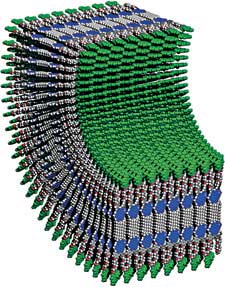| Posted: Dec 19, 2006 |
Coaxial nanotube photoconductors |
|
(Nanowerk News) Through an assembly process that guides electron-donor and -acceptor molecules to form an uncommon structure, scientists have built novel nanoscale photoconductors. These microscopic energy converters are insulators in the dark but generate an electrical current under UV or visible light.
|
|
In the drive to shrink circuitry to nanometer dimensions, researchers have studied various strategies for making molecule-based photodetectors and other light-sensing devices. Typically, the electron-donor and electron-acceptor molecular components of the would-be devices form stacks of charge-transfer complexes when brought together. In such assemblies, charge carriers (electrons and holes) generally recombine too quickly to sustain a current.
|
 |
| Electron-rich (blue is HBC) and electron-poor (green is TNF) regions are segregated in the walls of a nanotube photoconductor, as shown in this cross section. (Image: Takuzo Aida)
|
|
Now, scientists in Japan have demonstrated that molecules composed of an electron-accepting trinitrofluorenone (TNF) unit covalently bonded to electron-donating hexabenzocoronene (HBC) can assemble spontaneously under select conditions into coaxial nanotubes. Current-voltage profiles measured during irradiation indicate that the nanotubes are strong photoconductors (Science 2006, 314, 1761). The tube walls consist of a segregated HBC region sandwiched between two TNF layers. This uncommon structure, which was determined on the basis of electron microscopy, X-ray analysis, and other probes, is one of the keys to the nanotubes' optoelectronic properties, according to the research team.
|
|
The team includes University of Tokyo chemistry professor Takuzo Aida, Yohei Yamamoto, Takanori Fukushima, and participants in the Aida Nanospace Project.
|
|
The investigation builds upon the group's earlier work with helical, HBC-based nanotubes that become conductive (not photoconductive) upon oxidation. Following that study, the team searched for photoconductivity in related materials and found that the results depend strongly on synthesis conditions. For example, very low concentrations of HBC-TNF containing a single TNF group lead to the desired (hollow) nanotubes. In contrast, higher concentrations yield solid microfibers that do not photoconduct, the researchers report. They also note that a modified form of HBC-TNF with two TNF units does not form nanotubes.
|
|
"The work marks a breakthrough in the emerging field of supramolecular electronics," says Frank Würthner, a chemistry professor at the University of Würzburg, in Germany. Würthner acknowledges that incorporating self-assembled nanostructures in today's microelectronics technology poses "severe challenges," but he notes that such materials may lead to new types of nanocircuitry.
|
|
Pointing out structural similarities between the coaxial nanotubes and light-harvesting antennae in some bacteria, Würthner adds that in the future, such nanodevices may be able to communicate with biological systems that have similar dimensions and are based on similar organizing principles.
|

